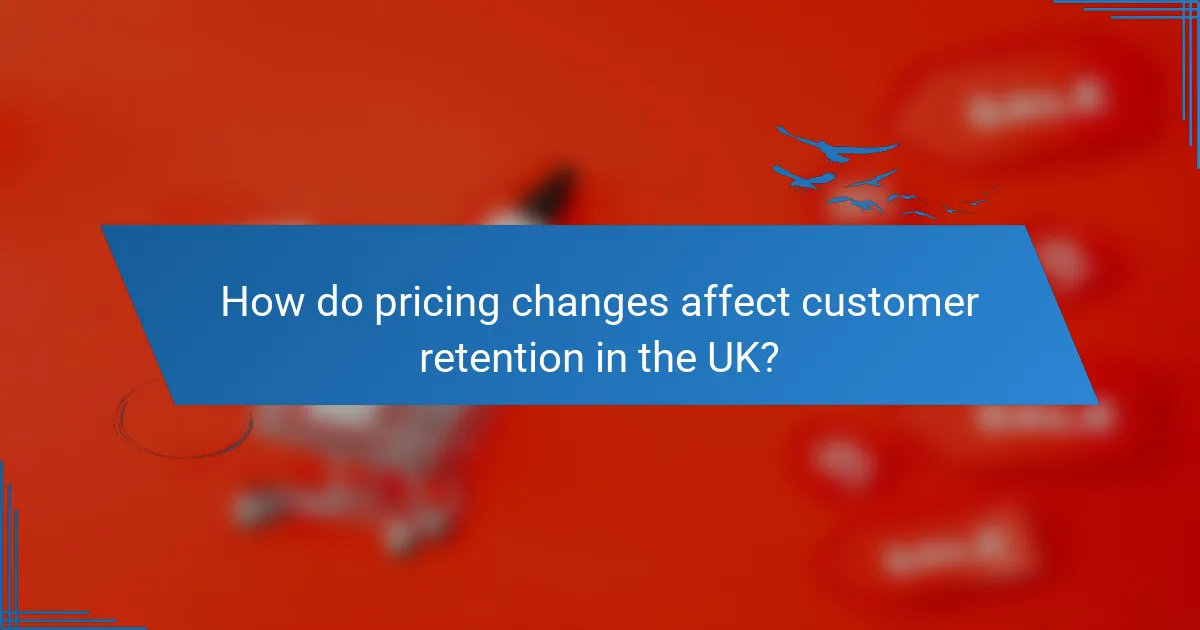Pricing changes can have a profound effect on customer retention, as they influence how customers perceive value and satisfaction. To navigate these shifts successfully, businesses must communicate transparently, incentivize loyalty, and customize offers to meet individual preferences, thereby fostering trust and engagement.

How do pricing changes affect customer retention in the UK?
Pricing changes can significantly impact customer retention in the UK by altering perceived value and satisfaction. When prices increase or decrease, customers may reassess their loyalty based on the new pricing structure and their alternatives.
Increased churn rates
When prices rise, many customers may choose to leave for more affordable options, leading to increased churn rates. Businesses often see a spike in cancellations shortly after a price hike, particularly if the increase is perceived as unjustified or excessive.
To mitigate churn, companies should communicate the reasons behind price changes clearly and highlight any added value. Offering loyalty discounts or phased increases can also help retain customers during transitions.
Customer dissatisfaction
Pricing changes can lead to customer dissatisfaction, especially if they feel the new prices do not reflect the quality or service they expect. This dissatisfaction can manifest in negative reviews and decreased brand loyalty.
To address this, businesses should actively seek customer feedback before implementing price changes. Engaging customers in discussions about pricing can foster a sense of involvement and understanding, reducing potential backlash.
Competitive pricing pressures
In a competitive market, pricing changes can trigger reactions from competitors, leading to price wars that can erode profit margins. Companies must be aware of their competitors’ pricing strategies and adjust accordingly to maintain market share.
Monitoring competitor pricing and market trends is crucial. Businesses should consider value-added services or unique offerings instead of solely competing on price, which can help differentiate them in a crowded marketplace.

What strategies can improve customer retention after pricing changes?
Improving customer retention after pricing changes involves clear communication, incentivizing loyalty, and tailoring offers to individual preferences. These strategies help maintain trust and engagement, minimizing the risk of customer churn.
Transparent communication
Transparent communication is crucial when implementing pricing changes. Inform customers about the reasons behind the adjustments and how they will benefit from them. This can include sharing insights into improved services or products that justify the new pricing.
Consider using multiple channels for communication, such as email, social media, and website announcements. Providing a FAQ section can also address common concerns and reinforce trust.
Loyalty programs
Loyalty programs can effectively enhance customer retention by rewarding repeat purchases. Implementing a tiered system where customers earn points for each purchase can encourage ongoing engagement. For example, offering discounts or exclusive access to new products can incentivize continued loyalty.
Ensure that the rewards are perceived as valuable and attainable. Regularly review and adjust the program based on customer feedback to keep it relevant and appealing.
Personalized offers
Personalized offers cater to individual customer preferences and behaviors, making them feel valued. Utilize customer data to create tailored promotions that resonate with specific segments. For instance, offering discounts on frequently purchased items can enhance the shopping experience.
Consider employing automated marketing tools to deliver these personalized offers at optimal times. This approach not only boosts retention but also encourages higher spending per transaction.

What are the best practices for implementing pricing changes?
Implementing pricing changes effectively requires a strategic approach that considers market dynamics and customer perceptions. Best practices include thorough research, testing different pricing models, and actively seeking customer feedback to ensure retention and satisfaction.
Conducting market research
Market research is essential for understanding competitive pricing and customer expectations. Analyze competitors’ pricing strategies, market trends, and economic conditions to identify optimal price points. Utilize tools like surveys, focus groups, and industry reports to gather relevant data.
Consider segmenting your market to tailor pricing strategies for different customer groups. For example, premium pricing may work well for high-end products, while value pricing could attract budget-conscious consumers.
Testing pricing models
Testing various pricing models helps determine which approach maximizes revenue while maintaining customer loyalty. Implement A/B testing to compare different price points or promotional offers, allowing you to see which resonates best with your audience.
Common pricing strategies include cost-plus pricing, value-based pricing, and dynamic pricing. Each has its advantages and trade-offs, so evaluate which aligns best with your business goals and customer needs.
Gathering customer feedback
Customer feedback is crucial for assessing the impact of pricing changes. Use surveys, interviews, and social media channels to solicit opinions on new prices and perceived value. This feedback can guide adjustments and enhance customer satisfaction.
Monitor customer behavior post-implementation, such as changes in purchase frequency or churn rates. Address any concerns promptly to maintain trust and loyalty, and consider offering incentives for feedback to encourage participation.

How can subscription models adapt to pricing changes?
Subscription models can adapt to pricing changes by implementing strategies that maintain customer loyalty while adjusting to market demands. Key approaches include offering flexible pricing tiers, introducing value-added services, and providing trial periods to ease transitions.
Flexible pricing tiers
Flexible pricing tiers allow customers to choose plans that best fit their needs and budgets. By offering multiple levels of service, businesses can cater to a wider audience and reduce churn rates during price adjustments. For instance, a streaming service might provide basic, standard, and premium options at different price points.
When designing these tiers, consider the features included at each level. Ensure that the value proposition is clear, and avoid overwhelming customers with too many choices. A good rule of thumb is to limit options to three to five tiers to simplify decision-making.
Value-added services
Value-added services enhance the core offering and justify pricing changes by providing additional benefits. Examples include exclusive content, personalized recommendations, or enhanced customer support. These services can create a perception of greater value, helping to retain customers even when prices increase.
To effectively implement value-added services, assess customer feedback and preferences. Tailor offerings to address specific needs, which can lead to higher satisfaction and loyalty. For example, a fitness app might include nutrition coaching or live workout sessions as part of a premium subscription.
Trial periods
Trial periods allow potential customers to experience the service before committing to a subscription. This strategy can be particularly effective when introducing new pricing structures, as it reduces perceived risk. Offering a 7 to 30-day trial can encourage users to explore the service without financial pressure.
To maximize the effectiveness of trial periods, ensure that the onboarding process is smooth and that users understand the value of the service. Follow up with reminders as the trial period nears its end, and consider offering a discount for early conversion to a paid plan to incentivize sign-ups.

What role does competitor analysis play in pricing strategies?
Competitor analysis is crucial for developing effective pricing strategies as it helps businesses understand market positioning and customer expectations. By examining competitors’ pricing models, companies can identify opportunities for differentiation and ensure their prices remain competitive.
Identifying market trends
Identifying market trends involves analyzing shifts in consumer behavior, preferences, and economic conditions that affect pricing. Businesses should monitor industry reports, social media, and customer feedback to spot emerging trends. For instance, if a trend towards sustainability emerges, companies may need to adjust their pricing to reflect eco-friendly practices.
Regularly reviewing these trends helps businesses stay relevant and responsive, allowing them to anticipate changes before they impact sales.
Benchmarking against rivals
Benchmarking against rivals means comparing your pricing strategy with that of key competitors. This process involves assessing not only price points but also the value offered, such as product features and customer service. By understanding where your offerings stand in relation to competitors, you can make informed decisions about your pricing structure.
For example, if competitors are offering similar products at lower prices, consider whether you can enhance your value proposition or adjust your prices to remain attractive to customers.
Adjusting offers accordingly
Adjusting offers accordingly requires flexibility in pricing based on competitor analysis and market trends. This might involve introducing promotional pricing, bundling products, or offering discounts to attract price-sensitive customers. Businesses should regularly review their pricing strategies to ensure they align with market conditions and customer expectations.
It’s essential to avoid drastic price changes that could alienate existing customers. Instead, consider gradual adjustments and communicate value effectively to maintain customer loyalty while optimizing revenue.

How can businesses measure the impact of pricing changes?
Businesses can measure the impact of pricing changes by analyzing customer feedback, retention rates, and sales performance. These metrics provide insights into how pricing adjustments affect customer behavior and overall revenue.
Customer surveys
Customer surveys are a direct method to gauge reactions to pricing changes. By asking customers about their perceptions of value and willingness to pay, businesses can identify potential issues or areas for improvement. Surveys can be conducted online or in-person, and should include open-ended questions for qualitative insights.
Consider using a mix of quantitative (e.g., rating scales) and qualitative questions to capture a comprehensive view. Aim for a response rate of at least 10-20% to ensure reliability in the feedback received.
Retention metrics
Retention metrics help businesses understand how pricing changes influence customer loyalty. Key metrics include churn rate, repeat purchase rate, and customer lifetime value (CLV). Monitoring these figures before and after a price adjustment can reveal trends in customer retention.
For example, if churn rates increase significantly after a price hike, it may indicate that the new pricing is not aligned with customer expectations. Regularly tracking these metrics can help businesses make informed decisions about future pricing strategies.
Sales performance analysis
Sales performance analysis involves reviewing sales data to assess the impact of pricing changes on revenue. This includes examining overall sales volume, average transaction value, and revenue growth rates. Comparing these metrics before and after a pricing change can highlight its effectiveness.
Utilize tools like sales dashboards to visualize trends and identify patterns. Look for changes in sales performance across different customer segments, as some may respond differently to pricing adjustments. Regular analysis can help refine pricing strategies for better outcomes.
